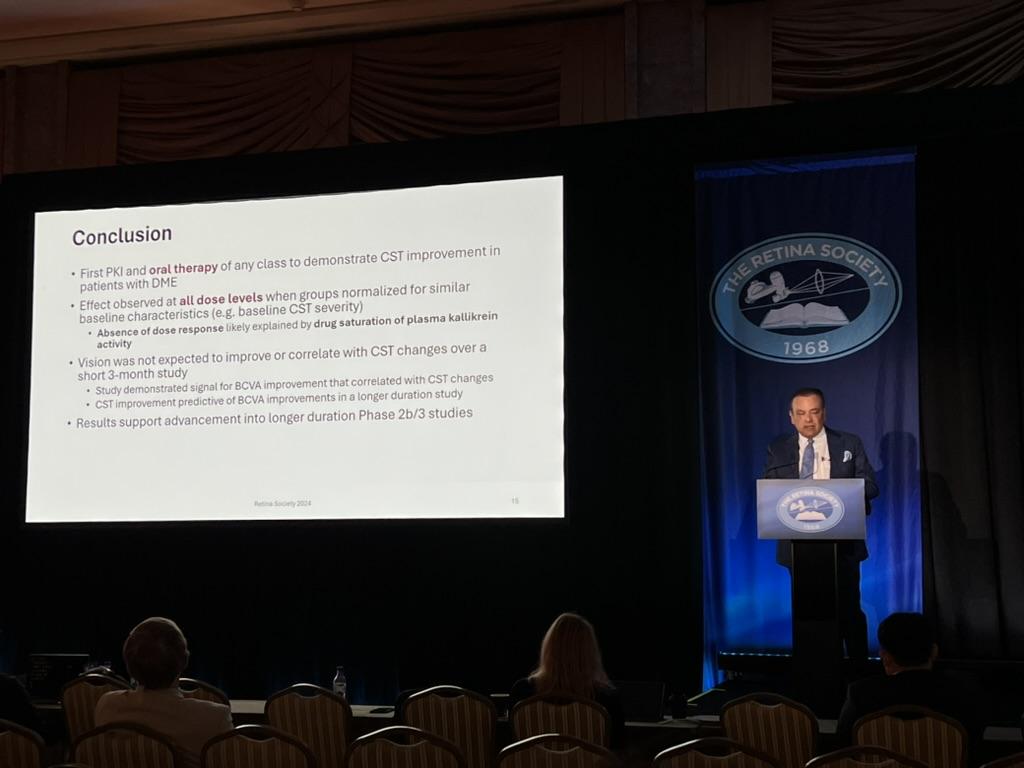Nikhil Bommakanti, MD
Wills Eye Hospital, Philadelphia, PA
Victor Gonzalez, MD and David A. Eichenbaum, MD presented late breaking abstracts at The Retina Society 57th Annual Scientific Meeting in September 2024.
Dr. Gonzalez presented the “Safety and Efficacy of RZ402, a Novel, Orally Administered Plasma Kallikrein Inhibitor, from a Phase 2a Study in Patients With Diabetic Macular Edema.” RZ402 is a novel oral medication studied for DME which is being developed by the pharmaceutical company Rezolute, Inc, from which Dr. Gonzalez receives financial research support.
Dr. Gonzalez explained that the kallikrein-kinin system (KKS) is an alternative pathway to target DME, as this system promotes vascular permeability, inflammation, and coagulation. In fact, plasma kallikrien (PK) overactivation leads to inflammation and macular edema, and preclinical and clinical data implicate the KKS as a VEGF-independent cause of DME. Yet, intravitreal PK inhibitors (PKIs) have been unsuccessful Dr. Gonzalez suggested this may be because a PKI should target the vascular site of action. Rezolute, Inc. is developing RZ402, an oral PKI intended to be taken once daily as either monotherapy or in combination with anti-VEGF injections. The oral dosing is intended to provide kallikrein inhibition at the retinal blood vessels of both eyes.
The purpose of his study was to evaluate safety, pharmacokinetics, and efficacy of RZ402, an orally-administered PKI, in patients with DME. This was a double masked, randomized, Phase 2a first-in-patient, proof-of-concept study. 94 diabetic patients with center-involved DME (CST greater than 320 in men and 305 in women) with or without NPDR (DRSS score ≤ 47), and with 78 or fewer ETDRS letters, who were either treatment-naïve or had less than three anti-VEGF injections were randomized equally into four arms (50, 200 or 400mg of RZ402, or placebo).
The study drug was taken once daily for 12 weeks. This was followed by a 4-week safety follow up. Patients received ophthalmic examination, fundus photography, OCT, as well as physical examination, ECG, and laboratory measurements (including serial RZ402 blood levels for pharmacokinetics). Primary endpoints were safety and efficacy, defined as change in CST. Secondary endpoints were change in BCVA, change in DRSS, the repeat-dose PK profile, and status of the untreated fellow eye.
Of the 94 patients enrolled, 5 received rescue treatment and 5 withdrew consent. Three patients in the treatment arms had 4 total serious adverse events which were judged by the investigator as unrelated to the study drug. Patients did not experience hepatic enzyme abnormalities or gastrointestinal intolerance, which has been seen with other PKIs. The remaining adverse events, which were experienced by 48% to 57% of all patients, including in the placebo group, were mild. CST improved up to 50 microns at all dose levels of RZ402 compared to placebo. There was no change in BCVA. The target concentration was achieved at all 3 dose levels and there was no dose response, which was thought to be due to drug saturation of PK activity.
Dr. Gonzalez concluded by stating that RZ402 was safe and well tolerated, and that these results support advancement into longer duration Phase 2b/3 studies.

Dr. David Eichenbaum presented the second late breaking abstract, “Interim Results from the PRISM Phase 1/2 Clinical Trial Evaluating Intravitreal 4D-150 in Adults With Neovascular Age-Related Macular Degeneration.” This Phase 1/2 clinical study evaluated AAV intravitreal gene therapy for neovascular AMD developed by the pharmaceutical company 4DMT, from which Dr. Eichenbaum receives research grant support.
Dr. Eichenbaum explained that 4D-150 is a single-dose intravitreal AAV vector gene therapy with a dual-transgene cassette which encodes aflibercept and a miRNA sequence which targets VEGF-C, thereby inhibiting 4 of the 5 members of the mammalian VEGF family. The PRISM study is a Phase 1/2 study with an open label Phase 1 dose exploration cohort as well as a Phase 2a randomized dose expansion cohort and a Phase 2b population extension cohort. The focus of this presentation was the week 24 results of the Phase 2 portion of the study.
![]()
Fifty one patients were randomized 2:2:1 to 2 doses of 4D-150 (1×1010 vg and 3×1010 vg) and aflibercept. Eyes which received 6 or more anti-VEGF injections in the preceding 12 months with a CST of 325 microns or more and SRF or IRF, as well as 34 to 83 ETDRS letters were included in the Phase 2a dose expansion study. Eyes which received 1 to 6 anti-VEGF injections in the preceding 12 months (with at least 1 injection in the preceding 12 weeks), with no minimum CST and the same BCVA requirements as in the Phase 2a study, were included in the Phase 2b population extension study. All patients received prophylactic topical steroids. Study endpoints included adverse events, supplemental anti-VEGF injections, and change in BCVA and CST.
![]()
The mean age ranged from 77 to 80 in Phase 2a and 77 to 78 in Phase 2b. Ninety to 100% of the patients were white, and the mean annualized prior injection rate was 9 to 10 in Phase 2a and 8.3 to 10.7 in Phase 2b. In the 3×1010 vg group, which is the intended dose for the Phase 3 study, there were no serious adverse events related to 4D-150 and there was no clinically significant inflammation. There was a 93% reduction in the annualized anti-VEGF injection rate, with 84% in Phase 2a and 93% in Phase 2b eyes receiving 1 or fewer supplemental anti-VEGF injections and 63% in Phase 2a and 77% eyes in Phase 2b remaining injection free at week 24. BCVA was stable at 24 weeks.
Dr. Eichenbaum concluded by stating that the company plans to initiate their Phase 3 study in early 2025.